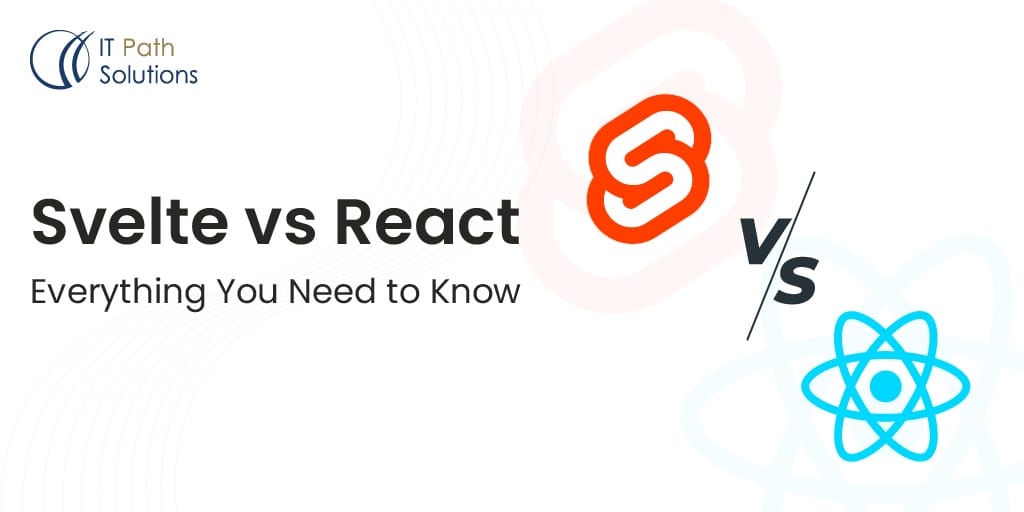Svelte vs React: Everything You Need to Know
ReactJS
Introduction
In the web development world, a new front-end framework comes out every day. Most come and go. But when it’s come to front-end web development, Svelte and React are two choices that come to our mind. Svelte and React are two front-end javascript frameworks that provide a productive approach to building web applications. As a front-end developer, you might have to choose the perfect framework for your project or webpage. With all javascript frameworks and libraries, Svelte and React are the most preferred choices for developers. But how should you choose one?. Let’s try and understand through this blog that you can choose the best framework for building web applications.
What is Svelte?
Svelte is a free open source java script compiler whose first version was released in 2016 with compiler. Svelte is a component based framework for building fast, flexible and secure front-end web applications. Svelte is lightweight, highly modular and fully customizable that can run on any device and support a javascript runtime environment such as Node.js. The Sveltekit framework was announced in 2020 and entered beta in 2021.
There are more than 3000 sites using Svelte around the world.
Svelte enables developers to build user interfaces without worrying about the complexity of implementing javascript and gives them countless tools for accomplishing their tasks. Svelte aims to be a more ligh-weight framework that provides speed, performance and an extremely simple API for building web applications.

What is React?
React is a popular and powerful JavaScript library used for building user interfaces in web applications. Developed and maintained by formerly Facebook now Meta, React allows developers to create interactive and dynamic UIs with absolute ease. At its core, React employs a component-based architecture, where the user interface is broken down into reusable and self-contained components. These components encapsulate their own logic and rendering, making it easier to manage and maintain complex UIs. There are roughly 11,908,579 websites using React.
Developers can utilise and chop and change the components to create a full fledged application. React uses a virtual DOM (Document Object Model) to efficiently update and render changes to the user interface. This virtual DOM minimizes the need for direct manipulation of the actual DOM, resulting in improved performance and a smoother user experience.
One of the key features that sets React apart is its unidirectional data flow. In React applications, data flows in a single direction, from parent components to child components. This makes it easier to track and manage the state of the application, leading to more predictable behaviour and easier debugging.
React also offers a vibrant ecosystem of tools and libraries, including React Router for handling navigation, Redux for state management, and a plethora of third-party components and libraries to enhance development efficiency. Whether you’re building a simple website or a complex web application, React’s flexibility, performance, and extensive community support make it a top choice when you want to hire React js developers.
Key Features of React
- Component-Based Architecture: React is built around the concept of reusable components. Developers can create modular UI components that encapsulate their own logic and rendering, making it easier to manage and maintain complex user interfaces.
- Virtual DOM: React uses a virtual representation of the DOM, which is an in-memory representation of the actual HTML DOM. This virtual DOM allows React to efficiently update and render changes to the user interface, improving performance and responsiveness.
- Unidirectional Data Flow: React enforces a unidirectional data flow, where data flows from parent components to child components. This helps maintain a predictable and easily debuggable application state.
- JSX (JavaScript XML): React uses JSX, a syntax extension for JavaScript, to define component structures. JSX allows developers to write HTML-like code within their JavaScript files, making it more intuitive to work with UI elements.
- Declarative UI: React promotes a declarative approach to building user interfaces. Developers specify what the UI should look like based on the current state, and React takes care of updating the actual DOM to match that desired state.
- React Native: React can be used to build not only web applications but also mobile applications. React Native, a framework built on top of React, enables the development of native mobile apps for iOS and Android using the same React component-based approach.
- Ecosystem and Community: React has a vibrant and active community with a vast ecosystem of libraries, tools, and extensions. This ecosystem includes popular state management solutions like Redux, routing libraries like React Router, and a wide range of third-party components and utilities that accelerate development.

Pros of React
- Component-Based Architecture: React promotes a modular and component-based approach to building user interfaces. This makes it easier to develop, maintain, and reuse UI components across your application.
- Virtual DOM: React’s virtual DOM efficiently updates and renders changes in the user interface, resulting in better performance and a smoother user experience.
- Declarative Syntax: React’s declarative syntax allows developers to describe how the UI should look based on the current state, rather than specifying each step of how to update the DOM. This makes code more readable and easier to debug.
- Reusability: React components are highly reusable. You can compose complex UIs by combining smaller, self-contained components, saving development time and effort.
- Strong Ecosystem: React has a vast ecosystem of libraries, tools, and extensions that can enhance development productivity. This includes state management solutions like Redux, routing libraries like React Router, and numerous UI component libraries.
- React Native: React can be used to develop native mobile applications through React Native, allowing for code reuse between web and mobile platforms.
- Community Support: React has a large and active community of developers. This means you can find extensive resources, tutorials, and solutions to common problems.
- Performance: React’s efficient rendering and minimal direct manipulation of the DOM contribute to excellent performance, even in complex applications.
- SEO-Friendly: React applications can be made SEO-friendly with server-side rendering (SSR) or static site generation (SSG) techniques, ensuring search engines can crawl and index your content effectively.
- Developer Tools: React provides useful developer tools, such as React DevTools, which offer insights into component hierarchies, state, and props, aiding in debugging and optimization.
- Facebook Backing: React was developed and is maintained by Facebook, ensuring its ongoing development and support from a major tech company.
- Easy Learning Curve: React’s simplicity and the availability of extensive documentation make it accessible for both beginners and experienced developers.
- Cross-Platform Compatibility: React can be used for web applications, progressive web apps (PWAs), and native mobile applications, offering versatility and code reusability.
Features of Svelte
Declarative Syntax: Svelte uses a declarative syntax for building user interfaces. You describe what your UI should look like, and Svelte takes care of updating the DOM efficiently.
No Virtual DOM: Unlike some other JavaScript frameworks like React or Vue, Svelte doesn’t rely on a virtual DOM. Instead, it compiles components to highly efficient JavaScript code that directly manipulates the DOM, resulting in faster updates.
Component-Based: Svelte encourages the use of components to build UI elements. Components are self-contained and can be reused throughout your application.
Reactive: Svelte components are inherently reactive. When the data in a component changes, the UI updates automatically, making it easy to create dynamic and responsive applications.
Two-Way Binding: Svelte provides a simple way to achieve two-way data binding between components and their data. This simplifies the handling of form inputs and user interactions.
Server-Side Rendering: Svelte can be used for server-side rendering (SSR) to improve the initial load time and SEO of your applications.
Pros of Svelte
Performance: Svelte is known for its exceptional performance. Unlike some other frameworks that rely on a virtual DOM, Svelte compiles components to highly optimized JavaScript code that directly manipulates the DOM. This leads to faster initial load times and more efficient updates, resulting in a smoother user experience.
Small Bundle Sizes: The output code generated by the Svelte compiler is typically smaller than equivalent code produced by other frameworks. This means smaller bundle sizes, which in turn leads to quicker page loads, especially on slower network connections or mobile devices.
No Boilerplate Code: Svelte minimizes the amount of boilerplate code you need to write, resulting in cleaner and more concise codebases. You don’t need to write additional code for setting up event listeners, managing state, or handling updates in the DOM.
Two-Way Binding: Svelte provides built-in support for two-way binding, simplifying the handling of form inputs and interactive UI elements.
Built-in Animations: Svelte offers built-in support for creating smooth animations and transitions, making it easier to add visually appealing effects to your web applications.
Comparison between Svelte vs React
Svelte and React are both popular JavaScript frameworks for building user interfaces, but they have distinct differences in how they work and what they offer to developers. Here’s a comparison between Svelte and React in various aspects:
Architecture:
React: React is a component-based library that uses a virtual DOM to efficiently update the actual DOM. Developers create UI components and manage the state of their applications.
Svelte: Svelte is a compiler-driven framework that compiles components into highly optimized JavaScript code. It directly manipulates the DOM without relying on a virtual DOM.
Performance:
React: React’s virtual DOM allows for efficient updates, but it can still introduce some performance overhead, especially in complex applications.
Svelte: Svelte is known for its excellent performance. It compiles components to highly optimized JavaScript, resulting in faster initial loads and updates.
Bundle Size:
React: React applications can have larger bundle sizes, especially when using additional libraries and tooling.
Svelte: Svelte produces smaller bundle sizes by default, contributing to faster load times.
Development Experience:
React: React offers a rich development ecosystem with a wide range of libraries and tools. However, it can require more setup and boilerplate code.
Svelte: Svelte provides a simpler and more intuitive development experience with less boilerplate code. It offers a smooth learning curve for beginners.
Community and Ecosystem:
React: React has a massive and mature ecosystem with a wide range of third-party libraries, tools, and community support.
Svelte: While the Svelte ecosystem is smaller in comparison, it is growing rapidly, and there are libraries and tools available for various needs.
Reactivity:
React: React components need to explicitly manage state updates using setState or hooks like useState and useEffect.
Svelte: Svelte components are inherently reactive, with automatic updates when data changes, making it simpler to create dynamic UIs.
Learning Curve:
React: React has a steeper learning curve, especially for newcomers, due to its complex ecosystem and concepts like JSX, props, and state management.
Svelte: Svelte is known for its gentle learning curve, thanks to its simplicity and lack of boilerplate.
This table provides a concise overview of the key differences between Svelte and React across various aspects of development.
| Feature | Svelte | React |
|---|---|---|
| Programming Model | Reactive programming, no virtual DOM | Component-based architecture, virtual DOM |
| Performance | Optimized compile-time code, fast runtime | Efficient virtual DOM diffing algorithm |
| Bundle Size | Small and optimized bundle | Depends on additional libraries and features |
| Learning Curve | Easier for beginners, simpler syntax | Steeper learning curve, JSX syntax |
| Tooling/Ecosystem | Growing ecosystem, Sapper for SSR | Vast ecosystem, React Router, Redux, etc. |
| Developer Exp. | Smooth development experience, HMR | React Developer Tools, robust debugging support |
Conclusion
The choice between Svelte and React for your project depends on various factors, including your project’s specific requirements, your team’s familiarity with the technologies, and your personal preferences. Both Svelte and React are popular JavaScript frameworks/libraries for building user interfaces, but they have different approaches and characteristics.
If you’re looking for a lightweight, high-performance solution with a gentle learning curve, Svelte is an attractive option. It excels in smaller to medium-sized projects, prototypes, or situations where runtime efficiency is paramount. Its simplicity, smaller bundle sizes, and direct DOM manipulation make it a compelling choice.
On the other hand, React stands as a robust and versatile choice for a wide range of projects. Its extensive ecosystem, flexibility for building web, mobile, or desktop applications, and well-established community support make it a top choice for large, complex applications. React’s component-based architecture and virtual DOM are well-suited for maintaining and scaling projects over time.
In the end, the “best” choice depends on the specifics of your project and your team’s familiarity with each framework. Consider the project’s size, complexity, performance needs, and your development team’s expertise to make an informed decision. In some cases, you might even find that a hybrid approach, using both Svelte and React in different parts of your application, is the most effective way to achieve your goals.
 Healthcare
Healthcare  Education
Education  Real Estate
Real Estate  Logistic
Logistic  Fitness
Fitness  Tourism
Tourism  Travel
Travel  Banking
Banking  Media
Media  E-commerce
E-commerce  Themes
Themes
 Plugins
Plugins
 Patterns
Patterns





